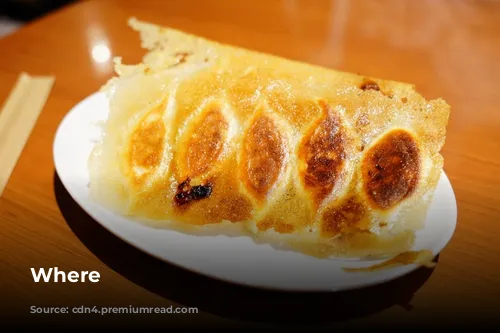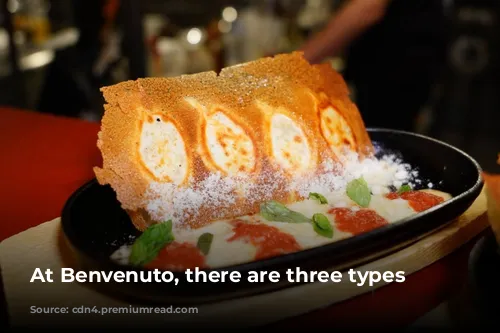Imagine this: You’re traveling through Japan, discovering countless unique dishes in every region. It’s a food lover’s dream! But what happens when a regional specialty takes on a life of its own, becoming a dish all its own?
This is the story of hanetsuki gyōza, a delightful twist on the classic fried dumplings.

From Humble Beginnings to Global Fame
Hanetsuki gyōza, literally “winged dumplings,” are a sight to behold. They’re filled with juicy meat and vegetables, steamed, then pan-fried to crispy perfection. But what truly sets them apart are their “wings,” thin and crispy flour and water flakes, added during the frying process.
You might think these crispy delights have been around for centuries, alongside the yaki gyōza (fried dumplings) that trace their roots back to ancient China. However, hanetsuki gyōza has a much more recent origin. Its creator, Isao Yagi, is still making them today!

A Culinary Journey: From China to Tokyo
Yagi’s restaurant, Nihao, sits nestled in Tokyo’s Ota Ward, a vibrant area with a distinct personality. It’s a far cry from the bustling heart of Tokyo, feeling more like a bustling city in its own right. You can easily reach Nihao from Kamata Station, a major transport hub in the area.
Nihao itself is a humble establishment, with a simple red awning and warm, inviting décor. It’s a place that feels like home, welcoming you with the aroma of delicious food.

The Story Behind the Winged Dumpling
Yagi, now 90 years old, is a true culinary pioneer. He moved to Japan from China in 1979, eager to learn the language and build a new life. He started by cooking the traditional boiled dumplings popular in China, but his Japanese teacher encouraged him to explore the fried variety, a staple in Japan.
Yagi embarked on a quest, visiting restaurants across Tokyo to study their gyōza making techniques. But he wasn’t satisfied, finding the flavors lacking. He spent countless hours experimenting in the kitchen, perfecting his recipe.
One day, as he cooked, Yagi was reminded of the shēng jiān bāo (fried pork buns) of his youth, their crispy bottoms a delightful contrast to the juicy filling. He decided to try the same technique with his gyōza, adding flour and water at the end of the frying process to create those irresistible “wings.”
His teacher was amazed and encouraged him to open a restaurant. And so, Nihao was born in 1983, quickly becoming a favorite among locals.
Hanetsuki Gyōza: A Flavorful Legacy
Nihao’s hanetsuki gyōza became a sensation, and Yagi proudly continued to perfect his craft. He’s dedicated to maintaining the highest quality, tasting every batch of gyōza every day. He’s even closed a branch in Ginza, a high-end district, because the customers complained that the flavor wasn’t quite the same as his main store’s.
Yagi’s commitment to quality shines through in every bite of his hanetsuki gyōza. The wings are light and crispy, while the skin is thick yet smooth. The filling is bursting with flavor, a perfect blend of juicy meat and crisp vegetables. Yagi insists on chopping all his ingredients by hand, ensuring a texture and taste that can’t be replicated by machines.
A Taste of Tradition, With a Twist
Hanetsuki gyōza isn’t just a culinary delight; it’s a testament to Yagi’s passion and dedication. He’s passed on his knowledge to his family, who have opened their own gyōza restaurants, Kangei and Benvenuto.
Kangei is a popular chain, offering a range of hanetsuki gyōza flavors. Then there’s Benvenuto, a unique twist on the classic with a touch of Italian flair. Located just a short walk from Nihao, Benvenuto has a cozy bistro atmosphere, with blackboard menus and a selection of wines.
Their hanetsuki gyōza menu includes margherita, quattro formaggi, and traditional varieties, each paired with a selection of dipping sauces. The margherita gyōza is especially interesting, with a tomato sauce and fresh basil that bring a touch of Italy to this classic Japanese dish.
Benvenuto is a testament to the evolution of hanetsuki gyōza, proving that this innovative dish can adapt to new flavors and styles while remaining true to its core identity.
The Enduring Legacy of Winged Dumplings
From humble beginnings to a global sensation, hanetsuki gyōza is a story of culinary innovation, passion, and family. Yagi’s dedication to quality and his willingness to experiment have created a dish that continues to surprise and delight food lovers around the world.
So next time you’re in Tokyo, be sure to visit Nihao and experience the magic of hanetsuki gyōza, a dish that’s truly out of this world!

